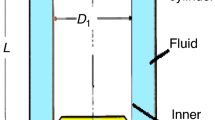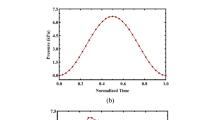Abstract
Quantitative analysis of blood viscosity was performed on the basis of mathematical models of non-Newtonian fluid shear flow behavior (Casson, Ree-Eyring and Quemada). A total of 100 blood samples were drawn from clinically stable survivors of myocardial infarction, treated with aspirin or acenocoumarol and controls to these drugs. Whole blood and plasma viscosity were measured at a broad range of shear rates using a rotary-oscillating viscometer Contraves LS40. Numerical analysis of the experimental data was carried out by means of linear (for Casson) and non-linear regression for the remaining models. In the evaluation of the results, both the fit quality and physical interpretation of the models’ parameters were considered. The Quemada model fitted most precisely with the experimental findings and, despite the controversies concerning the relationship between in vivo tissue perfusion and in vitro rheological measurements, seemed to be a valuable method enhancing investigation possibilities of cardiovascular patients. Our results suggest that aspirin does not affect blood rheological properties, while acenocoumarol may slightly alter red cell deformability and rouleaux formation.







Similar content being viewed by others
References
Baskurt OK, Yalcin O, Meiselman HJ (2004) Hemorheology and vascular control mechanisms. Clin Hemorheol Microcirc 30:169–178
Chmiel H (1979) Determination of blood rheological parameters and clinical application. Adv Cardiovasc Physiol 3:1–44
Cokelet GR (1987) The rheology and tube flow of blood. In: Skalak R, Chien S (eds) Handbook of bioenginering, chapter 14. McGraw Hill, New York
Cokelet GR, Brown JR, Codd SL, Seymour JD (2005) Magnetic resonance microscopy determined velocity and hematocrit distributions in a Couette viscometer. Biorheology 42:385–399
Easthope PL, Brooks DE (1980) A comparison of rheological constitutive functions for whole human blood. Biorheology 17:235–247
Eritsland J, Seljeflot I, Arnesen H et al (1992) Effects of long-term treatment with warfarin on fibrinogen FPA, TAT, and D-dimer in patients with coronary artery disease. Thromb Res 66:55–60
Eyring H (1936) Viscosity, plasticity, and diffusion as examples of absolute reaction rates. J Chem Phys 4:283–291
Huang CR, Chen HQ, Pan WD et al (1987) Effects of hematocrit on thixotropic properties of human blood. Biorheology 24:803–810
Junker R, Heinrich J, Ulbrich H et al (1998) Relationship between plasma viscosity and the severity of coronary heart disease. Arterioscler Thromb Vasc Biol 18:870–875
Kesmarky G, Toth K, Habon L et al (1998) Hemorheological parameters in coronary artery disease. Clin Hemorheol Microcirc 18:245–251
Kowal P (1998) Arterial hypertension decreases fibrinogen molecules contribution to the inter-red cells connection in stroke patients. Clin Hemorheol Microcirc 21:321–324
Lerche D, Bäumler H, Kucera W et al (1991) Flow properties of blood and hemorheological methods of quantification. In: Scütt W, Klinkmann H, Lamprecht I, Wilson T (eds) Physical characterization of biological cells. Basic research and clinic relevance. Verlag Gesundheit GmbH, Berlin pp 189–207
Lerche D, Koch B, Vlastos G (1993) Flow behavior of blood. Rheology 3:105–112
Lipowsky HH (2005) Microvascular rheology and hemodynamics. Microcirculation 12:5–15
Lowe G, Rumley A, Norrie J et al (2000) Blood rheology, cardiovascular risk factors, and cardiovascular disease: the West of Scotland Coronary Prevention Study. Thromb Haemost 84:553–558
Marcinkowska-Gapińska A, Jaroszyk F (1988) Chosen mathematical rheological models used in hemorheology Part II. Pol J Med Phys Eng 4:51–59
Marcinkowska-Gapińska A, Jaroszyk F, Górski S (1998) Application of Quemada rheological equation to analysis of blood flow curves in certain cases Part I. Pol J Med Phys Eng 4:39–49
Marcinkowska-Gapińska A, Jaroszyk F, Elikowski W et al. (2004) The effect of acetylsalicylic acid and acenocoumarin on rheological properties of blood studied on patients after myocardial infarction. Curr Top Biophys 28:3–8
Merrill EW (1969) Rheology of blood. Physiol Rev 49:863–888
Neofytou P (2004) Comparison of blood rheological models for physiological flow simulation. Biorheology 41:693–714
Pal R (2003) Rheology of concentrated suspensions of deformable elastic particles such as human erythrocytes. J Biomech 36:981–989
Press WH, Flannery BP, Teukolsky SA, Vetterling W (1989) Numerical recipes in Pascal: The art of scientific computing. Cambridge University Press, New York
Quemada D (1981) A rheological model for studying the hematocrit dependence of red cell–red cell and red cell–protein interactions in blood. Biorheology 18:501–516
Quemada D (1983) Blood rheology and its implication in flow of blood. In: Rodkiewicz CM (ed) Arteries and arterial blood flow. Springer, Heidelberg, pp 1–128
Ree T, Eyring H (1955) Theory of non-Newtonian flow. II. Solution system of high polymers. J Appl Physiol 26:800–809
Rosenson RS, Wolff D, Green D et al (2004) Aspirin does not alter native blood viscosity. J Thromb Haemost 2:340–341
Sandhagen B (1988) Assessment of blood rheology. Methodology and studies in healthy individuals, in patients with certain diseases and during liquid blood preservation. Acta Univ Ups, Uppsala, pp 1–52
Slyper A, Le A, Jurva J et al. (2005) The influence of lipoproteins on whole-blood viscosity at multiple shear rates. Metabolism 54:764–768
Stäubli M, Reinhart W, Straub PW (1982) Blood viscosity and red cell deformability after aspirin in vivo. A double-blind controlled trial. Atherosclerosis 41:167–170
Stoltz JF, Lucius M (1981) Viscoelasticity and thixotropy of human blood. Biorheology 18:453–473
Stuart J, Kenny MW (1980) Blood rheology. J Clin Pathol 33:417–429
Thurston GB (1979) Rheological parameters for the viscosity, viscoelasticity, and thixotropy of blood. Biorheology 16:149–162
Vaya A, Martinez M, Fernandez A et al. (2001) The effect of acenocoumarol on hemorheological parameters. Clin Hemorheol Microcirc 24:111–115
Yarnell JWG, Patterson CC, Sweetnam PM et al. (2004) Haemostatic/inflammatory markers predict 10-year risk of IHD at least as well as lipids: the Caerphilly collaborative studies. Eur Heart J 25:1049–1056
Author information
Authors and Affiliations
Corresponding author
Rights and permissions
About this article
Cite this article
Marcinkowska-Gapińska, A., Gapinski, J., Elikowski, W. et al. Comparison of three rheological models of shear flow behavior studied on blood samples from post-infarction patients. Med Bio Eng Comput 45, 837–844 (2007). https://doi.org/10.1007/s11517-007-0236-4
Received:
Accepted:
Published:
Issue Date:
DOI: https://doi.org/10.1007/s11517-007-0236-4




